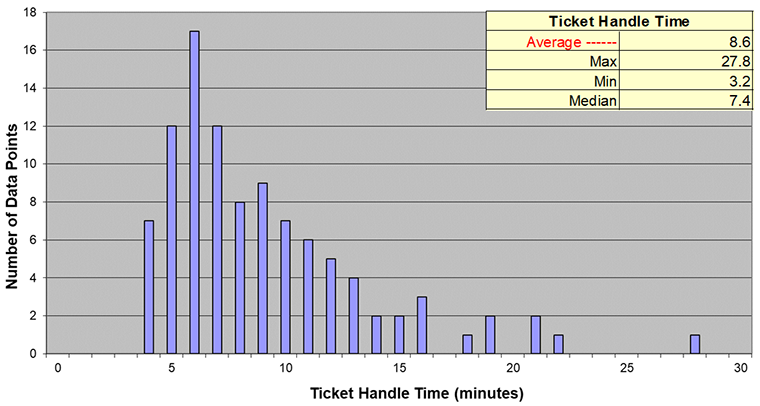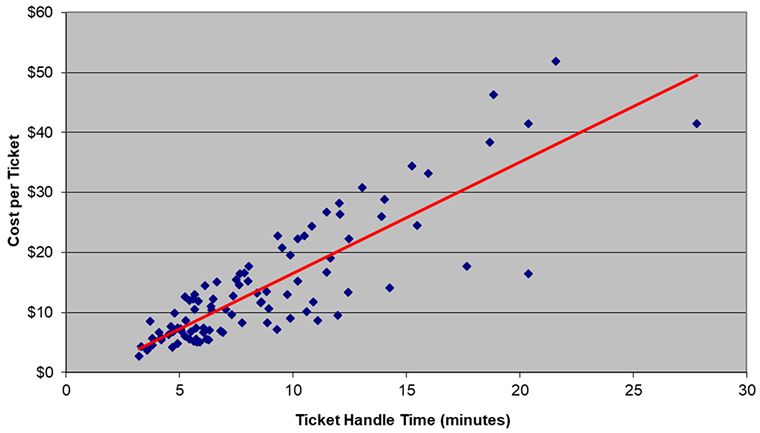Date Published March 26, 2019 - Last Updated December 17, 2019
Each month, I highlight one Key Performance Indicator (KPI) for service and support. I define the KPI, provide recent benchmarking data for the metric, and discuss key correlations and cause-and-effect relationships for the metric. The purpose of the column is to familiarize you with the KPIs that really matter to your organization and to provide you with actionable insight on how to leverage these KPIs to improve your performance! This month, I look at ticket handle time.
Ticket handle time is the average time that an agent spends on a service desk ticket, including talk time, chat time, wrap time, and after call or after chat work time (ACW). For non-live tickets, such as email and web submitted tickets, the ticket handle time is the average time that an agent spends working on the ticket before escalating or closing the ticket.
Please note that ticket handle time is not the same as mean time to resolve (MTTR). MTTR, sometimes called cycle time, is the average elapsed time from the beginning of an incident or service request, until the ticket associated with the incident or service request is closed. So, while the total handle time for an incident may be only 10 minutes, unless the ticket is resolved on first contact, the MTTR will be longer than the handle time. In fact, the MTTR can be substantially longer than the handle time depending upon how much after call work is required to resolve the issue and whether the ticket is escalated to another level of support for resolution.
Join Jeff for a metrics deep dive pre-conference workshop at HDI 2019
Learn more!
Why It’s Important
A ticket is the basic unit of work in a service desk. Ticket handle time, therefore, represents the amount of labor required to complete one unit of work. Additionally, it is an indirect measure of ticket complexity. As an example, a typical password reset has a handle time of one to three minutes. By contrast, a ticket for a proprietary business application in Oracle or SAP may have a handle time of 15 minutes or more.
Ticket handle time is an indirect measure of ticket complexity.

Ticket handle time has a direct impact on and is directly impacted by several other service desk metrics. One productivity metric that is strongly impacted by handle time is the number of tickets that an agent handles in a month. For a 10-minute handle time ticket, the average agent handles about 400 tickets per month. In a more complex environment, where the average handle time is 15 minutes, a typical agent might handle only 270 or so tickets per month. This, in turn, has headcount implications. A service desk that takes 5,000 inbound tickets per month with an average handle time of 15 minutes will require more agents than a service desk that handles 5,000 tickets per month with an average handle time of 10 minutes.
First contact resolution and first level resolution also have an impact on ticket handle time. In general, handle times increase as the first contact and first level resolution rates increase. This stands to reason because it is the more difficult/complex tickets that are typically dispatched and/or escalated to higher levels of support, and an increase in FCR and FLR is an indication that the service desk is resolving a more complex set of tickets (read longer handle times) at level 1.
Since ticket handle time is a proxy for complexity, service desks with longer handle times generally require more experienced agents. To continue with our earlier example, an agent that is expected to reset passwords and support basic desktop applications such as Microsoft Office and Windows does not need the level of experience or expertise that would be required of an agent that is expected to resolve incidents related to more complex business applications. This, of course, has implications for training. Inasmuch as longer handle times represent more complex incidents, agents supporting these environments require more training and experience to be successful.
Perhaps the most significant implication of handle time is the impact it has on cost per ticket. For obvious reasons, cost per ticket increases as the average handle time increases. Furthermore, this is one of the few linear relationships in IT support. As such, projecting cost per ticket vs. handle time can be done very accurately and is a relatively straightforward exercise.
Benchmarking Data for Ticket Handle Time
Industry data from MetricNet’s benchmarking database shows that the average ticket handle time for all service desks is 8.6 minutes.

The figure below shows the correlation between cost per ticket and ticket handle time. Although the relationship is linear, there is a fairly large variance around the mean (red line). This is due to differences in wage rates in different geographies, as well as the higher salaries paid to agents in the longer handle time (more complex) environments.

Please join me for next month’s Metric of the Month: Call Abandonment Rate, a service level metric that has implications for agent staffing and utilization.
Jeff Rumburg is the winner of the 2014 Ron Muns Lifetime Achievement Award, and was named to HDI’s Top 25 Thought Leaders list for 2016. As co-founder and CEO of MetricNet, Jeff has been retained as an IT service and support expert by some of the world’s largest corporations, including American Express, Hewlett Packard, Coca-Cola, and Sony. He was formerly CEO of the Verity Group and Vice President of Gartner. Jeff received his MBA from Harvard University and his MS in Operations Research from Stanford University. Contact Jeff at
[email protected]
. Follow MetricNet on Twitter @MetricNet.